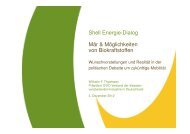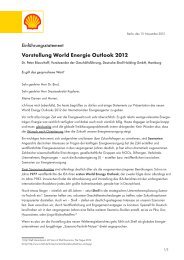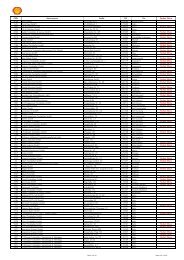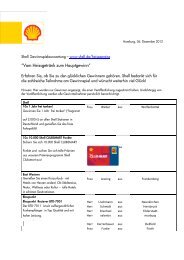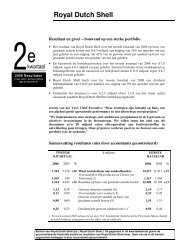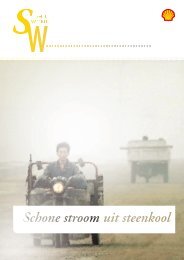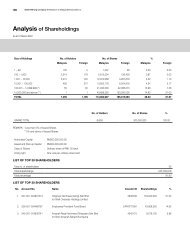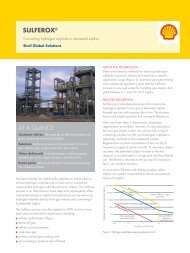ENVIRONMENTAL STATEMENT BARDOLINO DEVELOPMENT
ENVIRONMENTAL STATEMENT BARDOLINO DEVELOPMENT
ENVIRONMENTAL STATEMENT BARDOLINO DEVELOPMENT
Create successful ePaper yourself
Turn your PDF publications into a flip-book with our unique Google optimized e-Paper software.
Bardolino Development Environmental Statement<br />
their lifecycle in the pelagic stage before settling on the benthos. Important groups within this<br />
category include the larvae of starfish and sea urchins (echinoderms), crabs and lobsters<br />
(decapods), and some fish (DTI, 2001).<br />
Zooplankton in the area of the proposed development comprises mostly neritic (coastal)<br />
species and intermediate (mixed water) species, with biomass peaking from early May to mid-<br />
July until October. The euphasusiid species, Thysanoessa inermis and T. raschi dominate<br />
during the spring and summer months. During late summer and autumn, there is an<br />
introduction of oceanic species (such as Calanus finmarchicus and Metridia lucens) via an<br />
inflow of Atlantic waters.<br />
Zooplankton communities can be affected by oil, both directly through the hydrocarbon<br />
content of their food and indirectly via a change in the ecosystem. Reduced egg production<br />
and an increase in juvenile mortality have been associated with oil contamination, and there is<br />
a strong suggestion that oil treated with dispersant has a more pronounced effect. Any<br />
possible long-term genetic changes caused by the disruption of internal chemical signals are<br />
difficult to recognise and likely to be subtle (SAHFOS, 2001).<br />
4.4.2 Benthos<br />
Benthic fauna comprises species which live either within the seabed sediment (infauna) or on<br />
its surface (epifauna). Such species, which may be either sedentary or motile, and may<br />
encompass a variety of feeding habits (i.e. filter-feeding, predatory or deposit-feeding),<br />
occupy a variety of different niches. Bacteria and benthic organisms play a major role in the<br />
decomposition of organic material that originates from primary production by phytoplankton in<br />
surface waters and settles on the seabed (NSTF, 1993). Some bacteria can degrade<br />
hydrocarbons and use it as a source of food source (Clark, 1996).<br />
Benthic fauna are also typically divided into various categories, principally according to size.<br />
The largest are the megafauna and this comprises animals, usually living on the seabed,<br />
which are large enough to be seen in bottom photographs and caught by trawl (i.e. brittle<br />
stars, sea urchins, sea cucumbers, sea spiders, sponges, corals). Macrofauna are defined as<br />
those animals that are between 250 µm and 300 µm in size. Meiofauna comprises the<br />
smaller interstitial animals (mainly nematode worms and harpacticoid copepods) with a lower<br />
size limit of between 45 µm and 62 µm.<br />
Colonisation of sediments by different species is largely dependent on the type of sediment<br />
present and its characteristics. Both physical and biological factors are important in<br />
determining species abundance and distribution, including seabed depth, water movements,<br />
salinity, temperature and available oxygen. Infaunal species are particularly vulnerable to<br />
external influences, which alter the physical, chemical or biological community of the<br />
sediment. Such infaunal organisms are largely sedentary and are thus unable to avoid<br />
unfavourable conditions. Each species has its own response and degree of adaptability to<br />
changes in the physical and chemical environment. Consequently the species composition<br />
and relative abundance in a particular location provides a reflection of the immediate<br />
environment, both current and historical (Clark, 1996).<br />
Benthic fauna are susceptible to physical disturbance of the seabed, for example from fishingtrawls,<br />
anchoring, pipeline trenching and rock dumping operations, or smothering from<br />
discharged cuttings (DTI, 2001). The effects of discharged cuttings on benthic fauna include<br />
physical smothering, the presence of potential toxins (heavy metals and hydrocarbons), and<br />
organic enrichment (BMT Cordah, 1998). The responses shown by benthic communities to<br />
cuttings discharges are the result of a combination of these effects. Directly below a<br />
development, beneath the cuttings pile, the impact is through smothering. Beyond this point,<br />
the effects of toxins and organic enrichment become more evident, and the changes in the<br />
species composition, diversity and abundance of benthic communities may be attributed to<br />
one or all of these impacts (BMT Cordah, 1998).<br />
In addition to the possible impact from drilling operations, accidental events such as major oil<br />
spills and blow-outs can result in oil reaching the seabed offshore. Effects reported from such<br />
accidents range from none detected (e.g. after the Ekofisk blowout in 1977) to chemical<br />
contamination but no acute biological effects detectable (e.g. after the wreck of the Braer in<br />
1993) (DTI, 2001).<br />
Page 4-20 April 2008


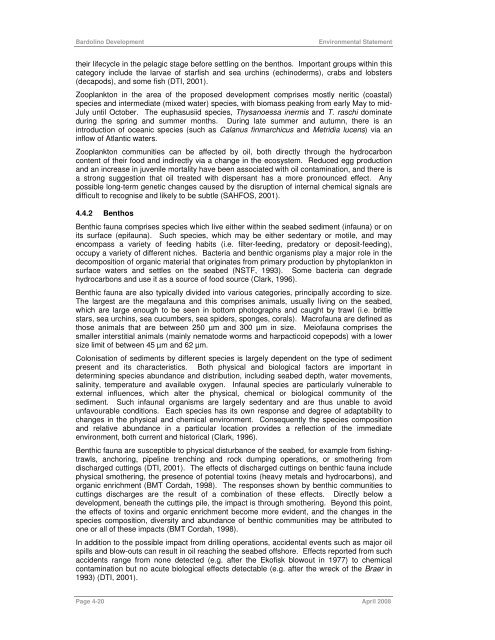

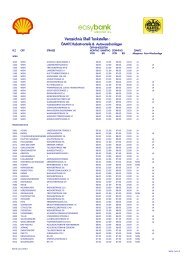
![Download Shell AutoGas Stationen [Stand: Januar 2013] (PDF](https://img.yumpu.com/9982753/1/190x245/download-shell-autogas-stationen-stand-januar-2013-pdf.jpg?quality=85)
